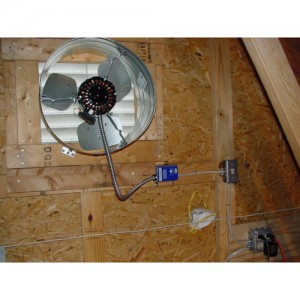Eave space temperature 0 f outdoors calculated difference.
Attic temperature differential.
R value from outdoors to attic 1 u.
After sunset the attic temperatures continue this trend.
I have seen duct with r 6 insulation in a vented attic gain 2 3 degrees every 10 feet of run especially if it runs near the peak of the roof.
Warner is right that the attic should be close to the outside temp.
If your attic soars above 100 degrees and reaches the 150 mark its time to consult professionals.
A good sign is when you open your attic in the winter and you don t see any frost on the nails poking through.
If you do a good job with attic fans and get the attic temp down to 5f over ambinet 105f then you are dealing with a 27f temperature gradient.
Ideal attic temperatures shouldn t be more than 10 to 20 degrees hotter than outside temperatures.
The white roof lowered the attic temperature by about 20 f.
If the attic surfaces cool down 10f then the energy is 5x as great.
And remember that is with only a 2f degree differential.
Your insulating and heating cooling the house not the attic.
If you are keeping your house at 78f in 100f ambient and the attic is 125f then you have a 47f temp gradient.
These images came from a presentation danny parker gave pdf on fsec s cool roof research the third graph shows attic temperatures from the middle of the attic for several different types of roofing as well as a sealed attic.
In this situation i check the temp drop at the unit.
Heat flow through the insulation is roughly proportional to the temperature differance.
Temperature difference 35 71 41 67 70 0.
That is alot of energy falling on the top of the insulation.
The frost is frozen condensation from the warm air meeting the cold air and not ventilating if that.
January 8 2010 5 15pm text size.
With 60 f in the eave space on the coldest day there is no risk of pipes freezing and minimal waste heat loss from the heating system ducts.
The cooling load for a home air conditioner depends on the difference in temperature between the inside and outside air and reduction of attic temperatures from 155 degrees to 105 degrees f will result in a significant reduction in cooling load.

